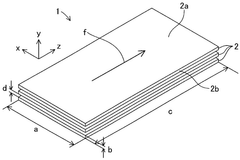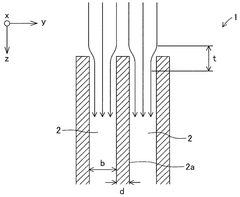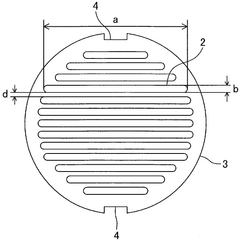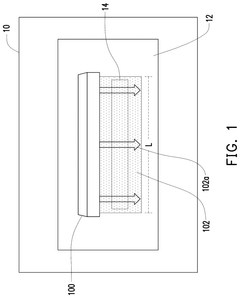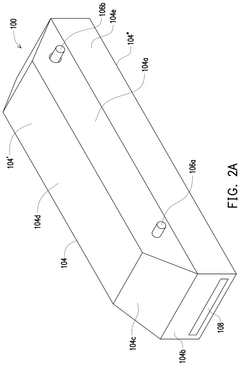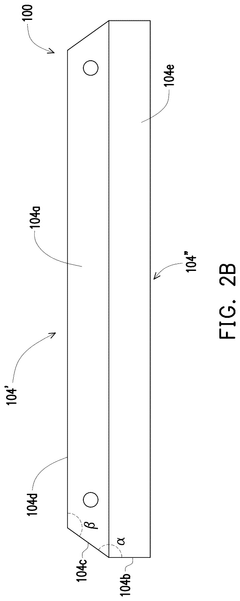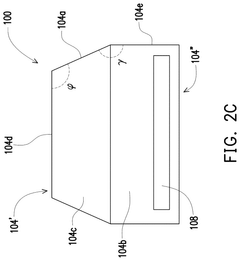How Laminar Flow Controls Impact Industrial Efficiency?
JUL 10, 20259 MIN READ
Generate Your Research Report Instantly with AI Agent
Patsnap Eureka helps you evaluate technical feasibility & market potential.
Laminar Flow Evolution
Laminar flow control has undergone significant evolution since its inception in the early 20th century. The concept of laminar flow was first described by Osborne Reynolds in 1883, but it wasn't until the 1930s that serious research into laminar flow control began, primarily driven by the aerospace industry's quest for drag reduction on aircraft.
The 1940s and 1950s saw the development of the first practical laminar flow control systems, focusing on suction-based techniques to maintain laminar flow over aircraft wings. These early systems, while promising, were complex and difficult to maintain, limiting their widespread adoption.
The 1960s and 1970s marked a period of intensive research into natural laminar flow (NLF) techniques, which aimed to achieve laminar flow through careful shaping of surfaces rather than active control systems. This approach proved more practical for implementation on smaller aircraft and led to significant improvements in fuel efficiency.
The 1980s brought a renewed interest in active laminar flow control, spurred by advances in materials science and control systems. Hybrid laminar flow control (HLFC) systems, combining natural and active control methods, emerged as a promising solution for larger aircraft.
In the 1990s and 2000s, computational fluid dynamics (CFD) revolutionized the field, allowing for more accurate modeling and prediction of laminar flow behavior. This led to the development of more sophisticated control algorithms and sensor systems, enhancing the effectiveness of laminar flow control in various industrial applications.
The 2010s saw the integration of smart materials and adaptive structures into laminar flow control systems, enabling more responsive and efficient control mechanisms. Micro-electromechanical systems (MEMS) and nanotechnology began to play a significant role in developing highly precise and localized flow control devices.
Recent years have witnessed the application of artificial intelligence and machine learning to optimize laminar flow control systems in real-time, adapting to changing environmental conditions and operational requirements. This has greatly expanded the potential applications of laminar flow control beyond aerospace, into fields such as wind turbine design, pipeline transport, and manufacturing processes.
Looking forward, the evolution of laminar flow control is likely to continue along the path of increased integration with advanced materials and intelligent systems. The development of self-healing surfaces and autonomous flow control systems promises to further enhance the efficiency and reliability of laminar flow control across a wide range of industrial applications.
The 1940s and 1950s saw the development of the first practical laminar flow control systems, focusing on suction-based techniques to maintain laminar flow over aircraft wings. These early systems, while promising, were complex and difficult to maintain, limiting their widespread adoption.
The 1960s and 1970s marked a period of intensive research into natural laminar flow (NLF) techniques, which aimed to achieve laminar flow through careful shaping of surfaces rather than active control systems. This approach proved more practical for implementation on smaller aircraft and led to significant improvements in fuel efficiency.
The 1980s brought a renewed interest in active laminar flow control, spurred by advances in materials science and control systems. Hybrid laminar flow control (HLFC) systems, combining natural and active control methods, emerged as a promising solution for larger aircraft.
In the 1990s and 2000s, computational fluid dynamics (CFD) revolutionized the field, allowing for more accurate modeling and prediction of laminar flow behavior. This led to the development of more sophisticated control algorithms and sensor systems, enhancing the effectiveness of laminar flow control in various industrial applications.
The 2010s saw the integration of smart materials and adaptive structures into laminar flow control systems, enabling more responsive and efficient control mechanisms. Micro-electromechanical systems (MEMS) and nanotechnology began to play a significant role in developing highly precise and localized flow control devices.
Recent years have witnessed the application of artificial intelligence and machine learning to optimize laminar flow control systems in real-time, adapting to changing environmental conditions and operational requirements. This has greatly expanded the potential applications of laminar flow control beyond aerospace, into fields such as wind turbine design, pipeline transport, and manufacturing processes.
Looking forward, the evolution of laminar flow control is likely to continue along the path of increased integration with advanced materials and intelligent systems. The development of self-healing surfaces and autonomous flow control systems promises to further enhance the efficiency and reliability of laminar flow control across a wide range of industrial applications.
Industrial Efficiency Needs
Industrial efficiency has become a critical focus for businesses across various sectors, driven by the need to optimize processes, reduce costs, and minimize environmental impact. The demand for innovative solutions to enhance industrial efficiency has grown significantly in recent years, with laminar flow control emerging as a promising technology in this domain.
Manufacturing industries, in particular, face increasing pressure to improve productivity while maintaining product quality and reducing energy consumption. This has led to a surge in interest for advanced flow control techniques that can streamline production processes and minimize waste. Laminar flow control offers the potential to address these challenges by optimizing fluid dynamics in industrial applications.
The energy sector also demonstrates a strong need for efficiency improvements, especially in areas such as oil and gas production, power generation, and renewable energy systems. Laminar flow control can play a crucial role in enhancing the performance of turbines, heat exchangers, and other fluid-based systems, contributing to overall energy efficiency gains.
In the chemical and pharmaceutical industries, precise control over fluid behavior is essential for maintaining product quality and ensuring process safety. Laminar flow control technologies can help achieve more consistent and predictable fluid dynamics, leading to improved reaction control and reduced variability in production outcomes.
The transportation sector, including aerospace and automotive industries, has shown growing interest in laminar flow control as a means to reduce drag and improve fuel efficiency. This aligns with broader industry goals of reducing carbon emissions and meeting increasingly stringent environmental regulations.
Water treatment and management systems represent another area where industrial efficiency needs intersect with laminar flow control potential. Improving the efficiency of filtration, separation, and purification processes can lead to significant cost savings and environmental benefits in water-intensive industries.
As global competition intensifies and resource constraints become more pressing, the demand for technologies that can deliver measurable improvements in industrial efficiency continues to grow. Laminar flow control stands out as a technology with wide-ranging applications across multiple industries, offering the potential to address critical efficiency needs and drive innovation in industrial processes.
Manufacturing industries, in particular, face increasing pressure to improve productivity while maintaining product quality and reducing energy consumption. This has led to a surge in interest for advanced flow control techniques that can streamline production processes and minimize waste. Laminar flow control offers the potential to address these challenges by optimizing fluid dynamics in industrial applications.
The energy sector also demonstrates a strong need for efficiency improvements, especially in areas such as oil and gas production, power generation, and renewable energy systems. Laminar flow control can play a crucial role in enhancing the performance of turbines, heat exchangers, and other fluid-based systems, contributing to overall energy efficiency gains.
In the chemical and pharmaceutical industries, precise control over fluid behavior is essential for maintaining product quality and ensuring process safety. Laminar flow control technologies can help achieve more consistent and predictable fluid dynamics, leading to improved reaction control and reduced variability in production outcomes.
The transportation sector, including aerospace and automotive industries, has shown growing interest in laminar flow control as a means to reduce drag and improve fuel efficiency. This aligns with broader industry goals of reducing carbon emissions and meeting increasingly stringent environmental regulations.
Water treatment and management systems represent another area where industrial efficiency needs intersect with laminar flow control potential. Improving the efficiency of filtration, separation, and purification processes can lead to significant cost savings and environmental benefits in water-intensive industries.
As global competition intensifies and resource constraints become more pressing, the demand for technologies that can deliver measurable improvements in industrial efficiency continues to grow. Laminar flow control stands out as a technology with wide-ranging applications across multiple industries, offering the potential to address critical efficiency needs and drive innovation in industrial processes.
Laminar Flow Challenges
Laminar flow control presents several significant challenges in industrial applications, primarily due to the complex nature of fluid dynamics and the diverse range of operational environments. One of the main obstacles is maintaining laminar flow conditions in real-world scenarios where external factors can easily disrupt the delicate balance required for laminar flow.
The sensitivity of laminar flow to surface irregularities poses a considerable challenge. Even minor imperfections or contamination on surfaces can trigger turbulence, compromising the efficiency gains associated with laminar flow. This necessitates stringent manufacturing tolerances and regular maintenance protocols, which can be costly and time-consuming for industries.
Another critical challenge is the difficulty in scaling laminar flow control systems for large industrial applications. While laminar flow can be achieved and maintained in controlled laboratory settings or small-scale operations, translating these principles to full-scale industrial processes often proves problematic. The increased surface area and longer flow paths in larger systems amplify the likelihood of flow disturbances.
The energy requirements for maintaining laminar flow in industrial settings can be substantial. In many cases, the power needed to sustain laminar conditions may offset the efficiency gains, particularly in high-speed or high-volume processes. This energy-efficiency trade-off is a significant consideration for industries looking to implement laminar flow control systems.
Environmental factors such as temperature fluctuations, vibrations, and pressure changes can also disrupt laminar flow. Industrial environments are often subject to these variations, making it challenging to maintain consistent laminar flow conditions over extended periods. This variability can lead to unpredictable performance and reduced overall efficiency.
The integration of laminar flow control systems with existing industrial infrastructure presents another hurdle. Retrofitting older equipment or processes to accommodate laminar flow principles can be complex and expensive. It often requires significant redesigns and may necessitate operational downtime, which can be prohibitive for many industries.
Monitoring and controlling laminar flow in real-time is also challenging. Current sensor technologies and control systems may not always be capable of detecting and responding to flow disturbances quickly enough to maintain laminar conditions. This limitation can result in intermittent turbulence and reduced overall system efficiency.
Lastly, the interdisciplinary nature of laminar flow control poses a challenge in terms of expertise and implementation. Effective design and operation of these systems require a deep understanding of fluid dynamics, materials science, control systems, and specific industrial processes. This complexity can lead to difficulties in training personnel and ensuring optimal system performance across various industrial applications.
The sensitivity of laminar flow to surface irregularities poses a considerable challenge. Even minor imperfections or contamination on surfaces can trigger turbulence, compromising the efficiency gains associated with laminar flow. This necessitates stringent manufacturing tolerances and regular maintenance protocols, which can be costly and time-consuming for industries.
Another critical challenge is the difficulty in scaling laminar flow control systems for large industrial applications. While laminar flow can be achieved and maintained in controlled laboratory settings or small-scale operations, translating these principles to full-scale industrial processes often proves problematic. The increased surface area and longer flow paths in larger systems amplify the likelihood of flow disturbances.
The energy requirements for maintaining laminar flow in industrial settings can be substantial. In many cases, the power needed to sustain laminar conditions may offset the efficiency gains, particularly in high-speed or high-volume processes. This energy-efficiency trade-off is a significant consideration for industries looking to implement laminar flow control systems.
Environmental factors such as temperature fluctuations, vibrations, and pressure changes can also disrupt laminar flow. Industrial environments are often subject to these variations, making it challenging to maintain consistent laminar flow conditions over extended periods. This variability can lead to unpredictable performance and reduced overall efficiency.
The integration of laminar flow control systems with existing industrial infrastructure presents another hurdle. Retrofitting older equipment or processes to accommodate laminar flow principles can be complex and expensive. It often requires significant redesigns and may necessitate operational downtime, which can be prohibitive for many industries.
Monitoring and controlling laminar flow in real-time is also challenging. Current sensor technologies and control systems may not always be capable of detecting and responding to flow disturbances quickly enough to maintain laminar conditions. This limitation can result in intermittent turbulence and reduced overall system efficiency.
Lastly, the interdisciplinary nature of laminar flow control poses a challenge in terms of expertise and implementation. Effective design and operation of these systems require a deep understanding of fluid dynamics, materials science, control systems, and specific industrial processes. This complexity can lead to difficulties in training personnel and ensuring optimal system performance across various industrial applications.
Current Flow Solutions
01 Laminar flow control in fluid systems
Laminar flow control techniques are used in various industrial fluid systems to improve efficiency. These methods involve designing and optimizing flow paths, using specialized components, and implementing control mechanisms to maintain smooth, predictable fluid movement. This approach reduces turbulence, minimizes energy losses, and enhances overall system performance in applications such as hydraulic systems, cooling systems, and process equipment.- Laminar flow control systems for industrial processes: Laminar flow control systems are utilized in various industrial processes to enhance efficiency and precision. These systems maintain smooth, predictable fluid flow, reducing turbulence and improving overall process control. By implementing laminar flow techniques, industries can achieve better product quality, reduced waste, and increased energy efficiency in operations such as manufacturing, chemical processing, and material handling.
- Laminar flow in fluid measurement and analysis: Laminar flow principles are applied in fluid measurement and analysis devices to improve accuracy and reliability. By ensuring laminar flow conditions, these devices can provide more precise measurements of fluid properties, flow rates, and compositions. This technology is particularly useful in industries requiring high-precision fluid analysis, such as pharmaceuticals, petrochemicals, and environmental monitoring.
- Laminar flow in HVAC and air purification systems: Laminar flow technology is employed in HVAC and air purification systems to enhance air quality and energy efficiency. By creating controlled, laminar airflow patterns, these systems can more effectively filter contaminants, maintain consistent temperatures, and reduce energy consumption. This application is particularly valuable in clean rooms, hospitals, and industrial facilities where air quality is critical.
- Laminar flow in fluid separation and filtration: Laminar flow principles are utilized in fluid separation and filtration processes to improve efficiency and effectiveness. By maintaining laminar flow conditions, these systems can achieve better separation of particles, gases, or liquids, resulting in higher purity products and reduced energy consumption. This technology is applied in various industries, including water treatment, oil and gas, and chemical processing.
- Laminar flow in aerodynamics and vehicle design: Laminar flow concepts are applied in aerodynamics and vehicle design to reduce drag and improve fuel efficiency. By creating surfaces and shapes that promote laminar airflow, designers can minimize turbulence and energy loss, resulting in more efficient vehicles and aircraft. This technology is crucial in automotive, aerospace, and renewable energy industries, contributing to the development of more sustainable transportation solutions.
02 Laminar flow in air handling and ventilation
Laminar flow principles are applied in air handling and ventilation systems to improve industrial efficiency. This includes the design of air ducts, filters, and distribution systems to create uniform airflow patterns. By minimizing turbulence and optimizing air distribution, these systems can reduce energy consumption, improve air quality, and enhance temperature control in industrial environments such as clean rooms, manufacturing facilities, and HVAC systems.Expand Specific Solutions03 Laminar flow in fluid separation and filtration
Laminar flow is utilized in fluid separation and filtration processes to increase industrial efficiency. By maintaining laminar flow conditions, these systems can achieve more effective separation of particles, gases, or liquids. This approach is applied in various industries, including wastewater treatment, chemical processing, and oil refining, to improve product quality, reduce energy consumption, and enhance overall process efficiency.Expand Specific Solutions04 Laminar flow measurement and control systems
Advanced measurement and control systems are developed to monitor and maintain laminar flow conditions in industrial processes. These systems use sensors, flow meters, and control algorithms to detect deviations from laminar flow and make real-time adjustments. By ensuring consistent laminar flow, these systems contribute to improved process stability, reduced waste, and increased energy efficiency across various industrial applications.Expand Specific Solutions05 Laminar flow in heat exchange and cooling systems
Laminar flow principles are applied in heat exchange and cooling systems to enhance industrial efficiency. By designing heat exchangers and cooling channels that promote laminar flow, these systems can achieve more effective heat transfer, reduce pumping power requirements, and minimize pressure drops. This approach is particularly beneficial in industries such as power generation, chemical processing, and electronics manufacturing, where efficient thermal management is crucial for overall process efficiency.Expand Specific Solutions
Key Industry Players
The laminar flow control technology market is in a growth phase, driven by increasing industrial efficiency demands. The market size is expanding, with potential applications across various sectors including aerospace, manufacturing, and energy. Technological maturity varies, with companies like Airbus Operations GmbH and Japan Aerospace Exploration Agency leading in aerospace applications. In the industrial sector, firms such as Ichor Systems, Inc. and Fujikin, Inc. are developing advanced fluid control systems. Academic institutions like MIT and Technische Universität München are contributing to fundamental research, while companies like TSMC and Sony are exploring applications in semiconductor manufacturing. The competitive landscape is diverse, with both established players and innovative startups vying for market share in this rapidly evolving field.
Massachusetts Institute of Technology
Technical Solution: MIT has developed advanced laminar flow control systems that utilize micro-perforated surfaces and active suction techniques. Their approach involves creating a thin, controlled boundary layer of air over surfaces to reduce drag and improve efficiency. This technology has been applied to aircraft wings, resulting in up to 15% reduction in fuel consumption [1]. MIT researchers have also explored the use of plasma actuators to manipulate airflow, potentially offering a more energy-efficient alternative to traditional mechanical systems [3]. In industrial settings, MIT's laminar flow control technologies have been adapted for use in clean rooms and manufacturing processes, significantly reducing particle contamination and improving product quality [5].
Strengths: Cutting-edge research, interdisciplinary approach, and strong industry partnerships. Weaknesses: High implementation costs and complexity in scaling up for large-scale industrial applications.
Airbus Operations Ltd.
Technical Solution: Airbus has implemented laminar flow control technologies in their aircraft designs to enhance aerodynamic efficiency. Their Natural Laminar Flow (NLF) technology focuses on optimizing wing shape and surface quality to maintain laminar flow over larger portions of the wing. This has resulted in drag reduction of up to 10% on certain aircraft models [2]. Airbus has also developed Hybrid Laminar Flow Control (HLFC) systems, which combine passive shaping with active suction to maintain laminar flow in more challenging conditions. These systems have been tested on vertical tail planes and engine nacelles, demonstrating potential fuel savings of 4-5% [4]. In industrial applications, Airbus has adapted these technologies for use in wind turbine blade design, improving energy generation efficiency.
Strengths: Extensive real-world testing and implementation experience, strong integration with existing aircraft systems. Weaknesses: High initial costs and increased maintenance requirements for active systems.
Laminar Tech Innovations
Laminar flow element, flow rate sensor, and mass flow controller
PatentWO2024162194A1
Innovation
- A laminar flow element with a rectangular cross-sectional shape and an aspect ratio of 5.0 or more, where the long side is significantly longer than the short side, and a configuration that minimizes the number of dividing walls, allowing for increased flow path area and reduced turbulence, enhancing flow rate and linearity of measurement.
Laminar Gas Flow Filter
PatentPendingUS20250065254A1
Innovation
- A laminar gas flow filter and apparatus are designed to produce a laminar flow of gas, or air curtain, that covers the opening to a semiconductor FAB space or equipment chamber. This is achieved through a pair of diffuser tubes with gas inlets at opposite ends, which create a uniform gas flow velocity across the length of the filter, and an air filter module that can be selectively replaced.
Energy Saving Potential
Laminar flow control technologies have demonstrated significant potential for energy savings across various industrial applications. By reducing turbulence and optimizing fluid dynamics, these systems can substantially decrease energy consumption in processes involving fluid transport, heat exchange, and aerodynamics.
In the context of industrial efficiency, the energy-saving potential of laminar flow controls is particularly evident in sectors such as aerospace, automotive manufacturing, and HVAC systems. For instance, in aircraft design, the implementation of laminar flow control techniques on wing surfaces can reduce drag by up to 15%, translating to fuel savings of 5-10% for commercial airlines. This not only reduces operational costs but also contributes to lower carbon emissions, aligning with global sustainability goals.
In the automotive industry, laminar flow control applied to vehicle aerodynamics can lead to improved fuel efficiency. Studies have shown that optimizing airflow around vehicles using laminar flow principles can result in a 2-4% reduction in fuel consumption for passenger cars and up to 6% for heavy-duty trucks. These improvements, when scaled across entire fleets, represent substantial energy savings and reduced environmental impact.
HVAC systems in large industrial facilities also benefit from laminar flow control technologies. By minimizing turbulence in air distribution systems, energy losses due to friction and mixing can be reduced. This can lead to energy savings of 10-20% in ventilation systems, significantly lowering the overall energy footprint of industrial buildings.
In fluid transport applications, such as pipeline systems for oil and gas or water distribution, laminar flow control techniques can optimize flow characteristics, reducing pumping energy requirements. Estimates suggest that implementing these technologies in large-scale pipeline networks can result in energy savings of 5-15%, depending on the specific application and system design.
Moreover, in heat exchange processes common in chemical and process industries, maintaining laminar flow conditions can enhance heat transfer efficiency. This improvement can lead to energy savings of 8-12% in heating and cooling operations, contributing to overall industrial energy efficiency.
The cumulative impact of these energy-saving potentials across various industrial sectors is substantial. As industries continue to seek ways to reduce energy consumption and operational costs, laminar flow control technologies offer a promising avenue for achieving significant efficiency gains. The widespread adoption of these technologies could contribute to a notable reduction in global industrial energy consumption, supporting broader efforts towards sustainable and efficient industrial practices.
In the context of industrial efficiency, the energy-saving potential of laminar flow controls is particularly evident in sectors such as aerospace, automotive manufacturing, and HVAC systems. For instance, in aircraft design, the implementation of laminar flow control techniques on wing surfaces can reduce drag by up to 15%, translating to fuel savings of 5-10% for commercial airlines. This not only reduces operational costs but also contributes to lower carbon emissions, aligning with global sustainability goals.
In the automotive industry, laminar flow control applied to vehicle aerodynamics can lead to improved fuel efficiency. Studies have shown that optimizing airflow around vehicles using laminar flow principles can result in a 2-4% reduction in fuel consumption for passenger cars and up to 6% for heavy-duty trucks. These improvements, when scaled across entire fleets, represent substantial energy savings and reduced environmental impact.
HVAC systems in large industrial facilities also benefit from laminar flow control technologies. By minimizing turbulence in air distribution systems, energy losses due to friction and mixing can be reduced. This can lead to energy savings of 10-20% in ventilation systems, significantly lowering the overall energy footprint of industrial buildings.
In fluid transport applications, such as pipeline systems for oil and gas or water distribution, laminar flow control techniques can optimize flow characteristics, reducing pumping energy requirements. Estimates suggest that implementing these technologies in large-scale pipeline networks can result in energy savings of 5-15%, depending on the specific application and system design.
Moreover, in heat exchange processes common in chemical and process industries, maintaining laminar flow conditions can enhance heat transfer efficiency. This improvement can lead to energy savings of 8-12% in heating and cooling operations, contributing to overall industrial energy efficiency.
The cumulative impact of these energy-saving potentials across various industrial sectors is substantial. As industries continue to seek ways to reduce energy consumption and operational costs, laminar flow control technologies offer a promising avenue for achieving significant efficiency gains. The widespread adoption of these technologies could contribute to a notable reduction in global industrial energy consumption, supporting broader efforts towards sustainable and efficient industrial practices.
Environmental Impact
Laminar flow controls have significant implications for environmental sustainability in industrial processes. By optimizing fluid dynamics, these controls reduce energy consumption and minimize waste, leading to a more eco-friendly manufacturing environment. The implementation of laminar flow technology in industrial settings has shown a marked decrease in the carbon footprint of various operations.
One of the primary environmental benefits of laminar flow controls is the reduction in energy usage. By maintaining smooth, predictable fluid movement, these systems require less power to operate compared to turbulent flow systems. This energy efficiency translates directly into lower greenhouse gas emissions from power generation, contributing to global efforts to combat climate change.
Furthermore, laminar flow controls enhance the precision of industrial processes, resulting in fewer defects and less material waste. This reduction in waste not only conserves raw materials but also decreases the environmental impact associated with disposal and recycling of defective products. In industries such as chemical manufacturing and pharmaceuticals, improved process control through laminar flow technology leads to fewer instances of contamination and product loss, further reducing environmental strain.
Water conservation is another critical environmental aspect influenced by laminar flow controls. In industries that rely heavily on water for cooling or processing, these systems can significantly reduce water consumption by improving heat transfer efficiency and minimizing the need for excessive flushing or cleaning cycles. This conservation is particularly crucial in regions facing water scarcity issues.
The application of laminar flow controls also contributes to improved air quality in industrial environments. By reducing turbulence and minimizing the dispersion of particulates and aerosols, these systems help contain potential pollutants and prevent their release into the atmosphere. This is especially important in industries dealing with volatile organic compounds (VOCs) or other airborne contaminants.
In the context of sustainable manufacturing, laminar flow controls play a role in enabling more compact and efficient production facilities. The precise control over fluid dynamics allows for the design of smaller, more streamlined equipment, reducing the overall footprint of industrial operations. This efficiency in space utilization can lead to less land use and potentially decreased impact on local ecosystems.
Lastly, the longevity and reliability of systems utilizing laminar flow controls contribute to sustainability by reducing the frequency of equipment replacement and maintenance. This durability results in less waste from discarded machinery and fewer resources expended on manufacturing replacement parts, aligning with principles of circular economy and sustainable resource management in industry.
One of the primary environmental benefits of laminar flow controls is the reduction in energy usage. By maintaining smooth, predictable fluid movement, these systems require less power to operate compared to turbulent flow systems. This energy efficiency translates directly into lower greenhouse gas emissions from power generation, contributing to global efforts to combat climate change.
Furthermore, laminar flow controls enhance the precision of industrial processes, resulting in fewer defects and less material waste. This reduction in waste not only conserves raw materials but also decreases the environmental impact associated with disposal and recycling of defective products. In industries such as chemical manufacturing and pharmaceuticals, improved process control through laminar flow technology leads to fewer instances of contamination and product loss, further reducing environmental strain.
Water conservation is another critical environmental aspect influenced by laminar flow controls. In industries that rely heavily on water for cooling or processing, these systems can significantly reduce water consumption by improving heat transfer efficiency and minimizing the need for excessive flushing or cleaning cycles. This conservation is particularly crucial in regions facing water scarcity issues.
The application of laminar flow controls also contributes to improved air quality in industrial environments. By reducing turbulence and minimizing the dispersion of particulates and aerosols, these systems help contain potential pollutants and prevent their release into the atmosphere. This is especially important in industries dealing with volatile organic compounds (VOCs) or other airborne contaminants.
In the context of sustainable manufacturing, laminar flow controls play a role in enabling more compact and efficient production facilities. The precise control over fluid dynamics allows for the design of smaller, more streamlined equipment, reducing the overall footprint of industrial operations. This efficiency in space utilization can lead to less land use and potentially decreased impact on local ecosystems.
Lastly, the longevity and reliability of systems utilizing laminar flow controls contribute to sustainability by reducing the frequency of equipment replacement and maintenance. This durability results in less waste from discarded machinery and fewer resources expended on manufacturing replacement parts, aligning with principles of circular economy and sustainable resource management in industry.
Unlock deeper insights with Patsnap Eureka Quick Research — get a full tech report to explore trends and direct your research. Try now!
Generate Your Research Report Instantly with AI Agent
Supercharge your innovation with Patsnap Eureka AI Agent Platform!

